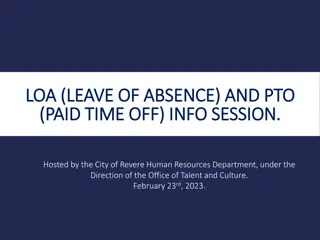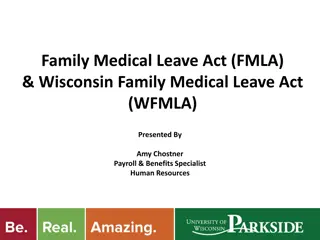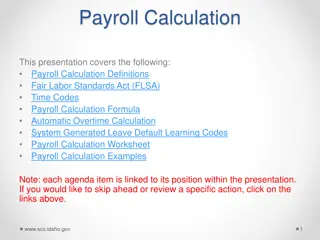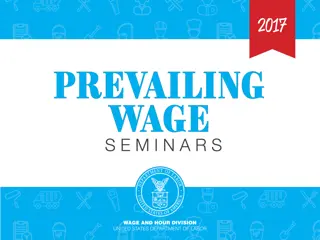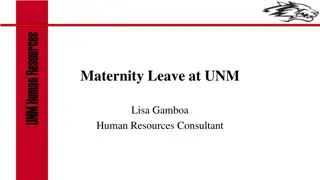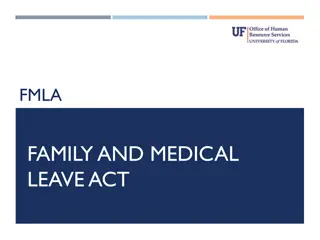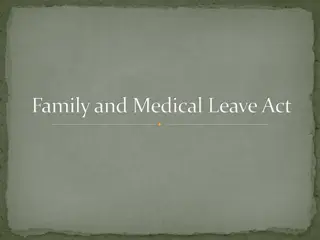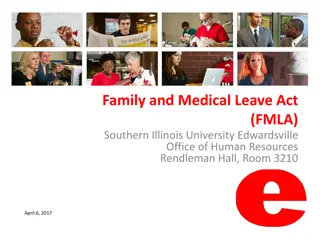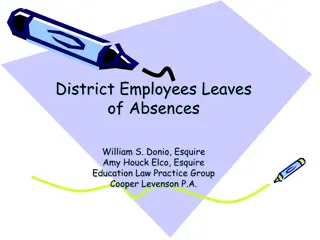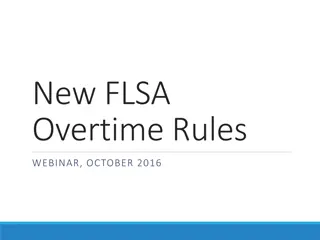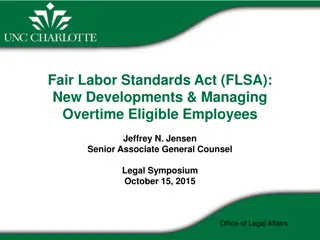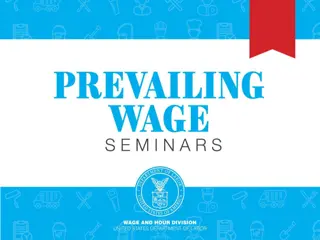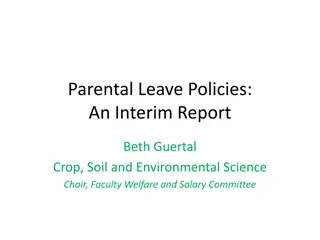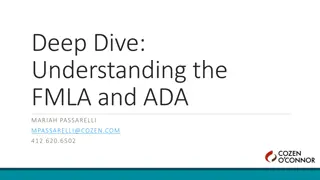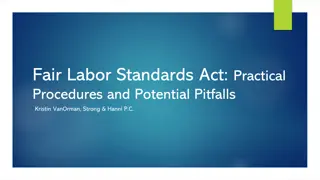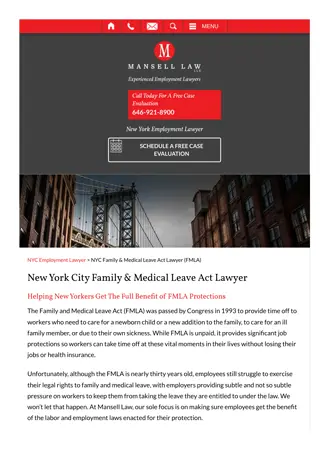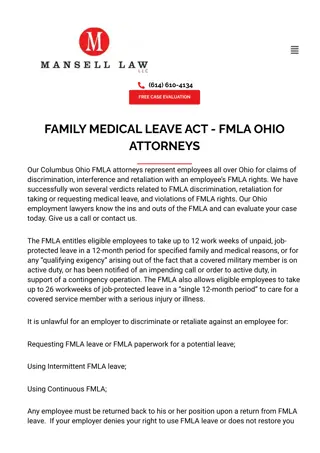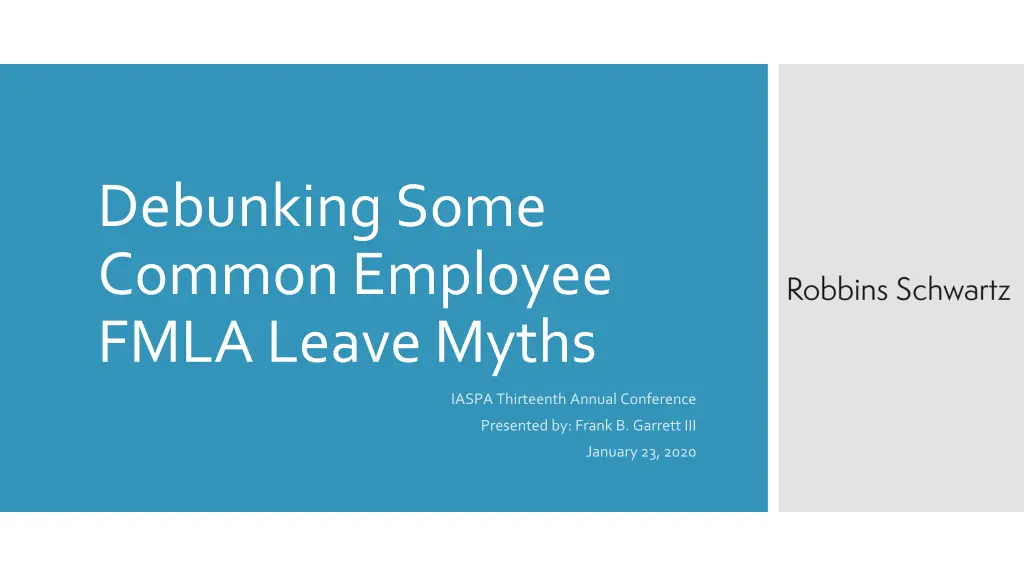
Debunking Common Employee FMLA Leave Myths - Overview and Reality
Understand the basics of Family and Medical Leave Act (FMLA) entitlements, eligibility criteria, reasons for leave, reinstatement conditions, and debunking common myths surrounding employee FMLA rights and responsibilities.
Download Presentation

Please find below an Image/Link to download the presentation.
The content on the website is provided AS IS for your information and personal use only. It may not be sold, licensed, or shared on other websites without obtaining consent from the author. If you encounter any issues during the download, it is possible that the publisher has removed the file from their server.
You are allowed to download the files provided on this website for personal or commercial use, subject to the condition that they are used lawfully. All files are the property of their respective owners.
The content on the website is provided AS IS for your information and personal use only. It may not be sold, licensed, or shared on other websites without obtaining consent from the author.
E N D
Presentation Transcript
Debunking Some Common Employee FMLA Leave Myths IASPA Thirteenth Annual Conference Presented by: Frank B. Garrett III January 23, 2020
Basic FMLA Principals The Family and Medical Leave Act entitles eligible employees of covered employers to take unpaid, job-protected leave for specified family and medical reasons with continuation of group health insurance under the same terms and conditions as if the employee had not taken leave. Overview An Eligible employee, in most circumstances, is entitled to 12 weeks of unpaid leave.
Basic FMLA Principals (continued) Eligible Employees are those: Employed by a covered employer as defined in the Act; Overview Employed for at least 12 months by the employer; and Worked at least 1,250 hours in the 12 month period immediately preceding the request for leave.
Basic FMLA Principals (continued) Eligible employees are entitled to FMLA leave for the following reasons: A serious health condition that renders the employee unable to perform the essential functions of his or her job. Overview The birth or placement of a son or daughter for adoption or foster care, or to care for the child. The care of the employee s son, daughter, spouse, or parent with a serious health condition.
Basic FMLAPrincipals (continued) An employee returning from a FMLA leave is entitled to reinstatement to the same or equivalent position. An employer may, an in most cases should require a Fitness-for-Duty certification from a returning employee.
Common FMLA Myth #1: An employee must be returned to the same position she held following FMLA Leave. Myth
No. At the end of an FMLA leave, an employee is entitled to reinstatement to the sameor equivalentposition as the employee held at the start of his/her leave. Reality
An equivalent position is defined as: A job that carries virtually identical pay, benefits, and working conditions, including privileges, prerequisites, and status, as the employee s prior job. FMLA Reinstatemen t The employee is entitled to reinstatement even if a replacement employee has been hired or the job has been restructured to accommodate the employee s absence.
Additional Considerations For purpose of employer layoffs an employee s FMLA leave should be treated as if it didn t happen. FMLA Restoration Request medical updates during the employee s leave when appropriate.
Common FMLA Myth #2 Employers only need to provide Parental Leave if it is required by the Collective Bargaining Agreement (CBA), Contract for Employment or Personnel Handbook. Myth
No! Eligible employees are entitled to parental leave under the FMLA as well as other federal and state laws. The FMLA provides eligible men and women up to 12 weeks of unpaid parental leave to care for a newborn, an adopted child or to place a child in foster care during the first year following birth, adoption or placement. Reality
Common FMLA Myth #3 Employees working for the same employer are each entitled to 12 weeks of FMLA leave for the birth of their child. Myth
Maybe. The FMLA provides that spouses of the same employer may be limited to a combined total of 12 weeks of leave for the birth of a child or to care for the child after birth or for adoption. Reality 12 weeks of leave includes both pre-and post-birth leave during 12 month period.
Common FMLA Myth #4 An employee s leave cannot be designated as FMLA leave if the employer failed to do so at the beginning of the leave. Myth
Not necessarily. Employers can retroactively designate leave as FMLA leave with appropriate notice to the employee provided that the employer s failure to timely designate leave does not cause harm or injury to the employee. Reality An employer and employee can also mutually agree to retroactive designation.
Important Things to Remember: An employee is not specifically required to request FMLA leave. The notice only need be sufficient enough to put employer on notice of possibility of need. FMLA Leave Notice Requirements An employer must notify an employee within 5 days of employee s notice if FMLA will apply, absent extenuating circumstances. The notice must say if leave will run concurrently and if a Fitness For Duty certification will be required.
Common FMLA Myth #5 Employees on FMLA leave are protected from workplace disciplinary action. Myth
FMLA leave does not insulate an employee from disciplinary action unrelated to the leave. If an employee would have been disciplined prior to, or regardless of their leave status, an employer can take action. Reality Employers should proceed with caution and only after consultation with counsel in this scenario to avoid an FMLA interference claim.
Scenario#1 Kanye W. is a religious studies teacher at your District. Kanye comes to you as HR coordinator and informs you that he needs a kidney transplant. He will need leave for dialysis regularly during his pre- scheduled office hours and will need extended leave when a donor is found. Unfortunately, it takes a while for Kanye to find a donor and he only has 10 days of leave remaining when he starts his leave for the transplant. Kayne informs you that he will need at least 30 days of leave. What do you tell him? Will Kanye be entitled to his same position when he returns to work? Is this answer the same if he had not used so much leave for dialysis? What if a new employee was hired as a replacement when Kanye was on leave?
A Review of Issues Which Still Cause Employers Trouble IASPA Thirteenth Annual Conference Presented by: Frank B. Garrett III January 23, 2020
The FLSA exemption from overtime pay requires the establishment of what three factors? FLSA Exempt Employee
For an employee to be considered exempt all three of the following must be met. 1. Salary of at least $684 per week or $35,568 per year (up from $455 per week and $23,00 per year); FLSA Exempt Employee 2. Payment on a regular salary basis; 3. Duties test The white collar exemption consists of Executive, Administrative and Professional employees.
The White Collar exemption requires regular performance of exempt duties: 1. Executive primary duty is management of an enterprise, or department; directs two or more employees and authority to hire or fire; FLSA Exempt Employee 2. Administrative office or non-manual work related to management of general business; and 3. Professional Duties performance of work requiring advanced knowledge in a field science or learning customarily acquired by a prolonged course of specialized instruction.
Which of these positions would be considered Professional Employees for FLSA exemption purposes? Teachers Certified Athletic Trainers Exempt Positions Paralegals Chefs Accountants Engineering Technicians Pharmacists LPNs
Workplace Scenario / Arriving to Work Early My assistant is not required to start work until 8:00 a.m., but lately has been arriving at 7:30 a.m. Is he entitled to be paid for this time? Scenario
Answer Maybe. Generally an employer is not required to pay the assistant unless he is actually performing work. However, work not requested, but suffered or permitted would be considered work time. Answer Any suggestions on how to address the assistant arriving to work 30 minutes early?
Computer Related Occupations Are the District s Computer Staff FLSA Exempt Employees?
It depends. The Department of Labors exempt duties typically include Computer Professionals. The FLSA computer exemption does not include computer professionals whose primary job functions involve manufacturing or repairing computer hardware vs. software engineering or systems analysis. Computer Related Occupations The FLSA computer exemption does not require the holding of certain degrees or certifications. Additionally, these employees must still meet the weekly salary minimum or be paid an hourly rate of at least $27.63.
Can an employees bonus and/or incentive payments and any commissions be used to meet the FLSA standard salary level? Scenario
To some degree, yes. The DOLs new rules allows companies to use such payments to satisfy up to 10% of the salary level if these payments are made on an annual basis. Answer
Which pay deductions can be made to an exempt employee s salary consistent with the FLSA? Personal day Pay Deductions FMLA leave day day suspension for disciplinary reasons Jury duty
Safe Harbor Rules if an Improper Deduction is made: Must have a policy prohibiting improper deductions; Safe Harbor Rules Reimburse any affected employee in a reasonable time; Make a good faith effort to comply in the future.



